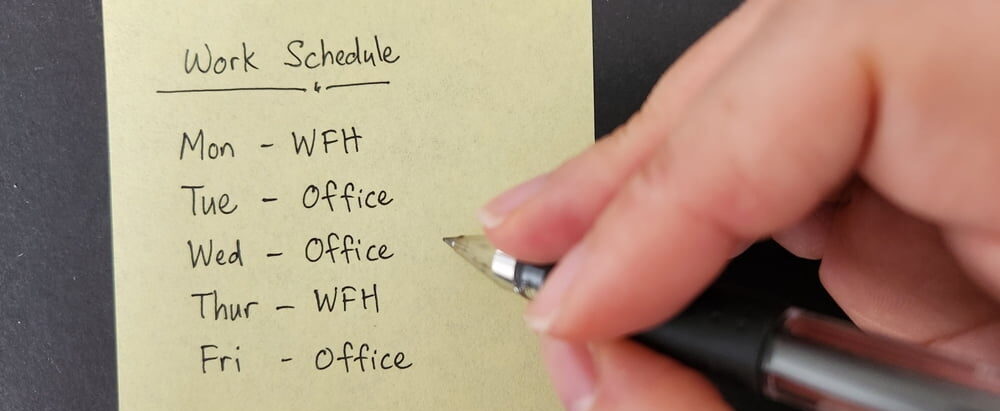The IML Great Virtual Debate: Is hybrid working better for business?
Last week we held a lively (virtual) debate on the topic: Is hybrid working better for business? We’ve heard a lot about the benefits for employees – but in this debate we were interested to know whether it makes sense from a commercial and business perspective.
Six passionate speakers shared many insightful arguments, and the debate was a close call. Ultimately, the affirmative team took the lead as the victors (58% for the affirmative team vs 42% for the negative team).
Interestingly, when we polled our attendees watching the debate live, 68% said they worked in a hybrid capacity and 22% noted that they worked exclusively from home. Only 10% worked onsite full-time.
Here’s a summary of each team’s arguments. Which side of the fence do you sit on?
Affirmative team – yes! Hybrid working is better for business
Kath Rimmer FIML argued that it was better for a company’s brand to support hybrid working and a great mechanism for retaining top talent. Kath also made the point that we need to move with the times. Remember the leaps and bounds we’ve made from typewriters, horses and carts and snail mail to today’s connected world?
The future of business is already here. Will you be a relic of the past like the typewriter or will you make the transition to remain competitive in the modern world of work.
Dr Herman Tse FIML suggested that it was easy to criticise but what was a better alternative model. Herman argued that we are now living in a brighter innovative world – why would we want to return to the old ways. The future is already in motion.
Herman introduced the first few letters of the affirmatives team’s acronym for the word ‘hybrid’:
- H = Human centric. Humans need flexibility and to be empowered to decide when, where and how they work. This provides greater purpose and meaning and increases engagement. It is a win/win for businesses and employees.
- Y = Yield. Studies show that hybrid employees can be equally or more efficient and productive than in-person counterparts.
- B = Balance. Work-life balance is not just a luxury. It is a fundamental element of the wellbeing of employees. Equilibrium can have a profound impact on job satisfaction and commitment and that is better for business and long-term success.
Dr Mofoluwaso Ilevbare FIML finished off the affirmative team’s arguments by reminding us that businesses are people and we need to look after our people. Mofoluwaso commented that every day there seems to be another article of a big corporate CEO suggesting that people must return to the office or risk losing their jobs. She questioned whether these are the types of managers that are autocratic and micromanage as their default style.
Mofoluwaso finished off the team’s acronym with the following:
- R = Resilience. Working in a hybrid way isn’t just about people – it is also about hybrid technology and processes. And these allow us to bounce back and operate even during disruptions.
- I = Inclusion. Hybrid work allows you to be more competitive and include a wider talent pool.
- D = Decentralisation. Hybrid can reduce operational costs and financial burdens on both employers and employees.
Mofoluwaso argues that there isn’t a single fixed office building that can fix bad management or leadership. If you’re a good manager, you will still be able to collaborate with your team online.
Out with the long lunch and in with spending more time with our families – because that is what we really want. Go hybrid or go extinct.
Negative team – no! Hybrid working is not better for business
Nader Seifen CMgr FIML kicked off the negative team’s arguments by reminding us that this was a debate about whether hybrid working was better for business. It must be better for all stakeholders in the business (shareholders, employees, customers etc.) simultaneously and if it is not, then it must be dismissed.
Nader suggested that hybrid working is a fad that arose from the need to hibernate. Now, we must move on. All great performing sports teams have one thing in common – they have a strong bond. To improve an organisation’s culture, people must be able to bond, and this cannot be done as well virtually.
Sian Stephens FIML introduced us to all the ways that hybrid work poses a risk to a business – whether that be occupational health and safety, psychosocial safety or cyber risk. Sian reminds us that leaders have been bombarded with one word over the past 18 months – recovery. Recovery. Recovery. Recovery. But all they’ve been faced with is risk.
As businesses, we used to be responsible for staff in one workspace. We now have responsibility for staff in sometimes hundreds of locations. This carries risk. And that risk has had a massive impact on CEO and leadership burnout rates.
Geoff Augutis FIML rounded out the arguments for the negative team suggesting that just because you can do something, doesn’t mean that you should. Hybrid work comes at a cost. Think about all of the things that we lose by not working face-to-face with colleagues and clients. Even Geoff, who leads a team working in the tech industry, admits that technology is an enabler, and not a replacement for real human contact. Young people need the opportunity to build interpersonal interaction skills and to be mentored. Geoff questioned: how can this happen in a hybrid environment?
Where do you sit?
This debate highlights a few things: there are pros and cons on both sides of the arguments, and businesses need to find a solution and model that works best for them.
When polled, 45% of our debate attendees said they would no longer consider applying for a role unless it offered hybrid work (20% were undecided). It is clear that we all want sustainable progress. Nobody wants to remain in the past!



